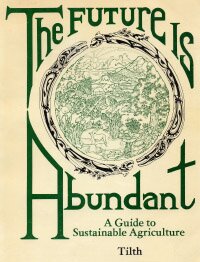
The Future is Abundant
A Guide to Sustainable Agriculture
Tilth Producers of Washington Home | WA Tilth Assoc. | Conference | Directory | Journal | Placement Service | Calendar | Action Alerts
Legislative Update | Bulletin Board | Classifieds | Questions on Agriculture? | Photo Gallery | Links | Contact Us | Join Now | Volunteer

One of nature's most extensive experiments in growing wild fruit and nut forests is in the Caucasus mountains and neighboring parts of Central Asia. In the Soviet Union there are approximately one million acres of forests where wild fruit and nut trees are dominant. These include walnut, chestnut, pistachio, almond, apple, pear, fig, pomegranate, persimmon and apricot. Most of these species are found as an admixture in forests, but some form pure stands over extensive areas. To illustrate a few of the lessons that nature has to teach us about natural tree crop ecosystems is a quote from The Forests of the USSR by V.P. Tseplyaev. It is interesting to note that many of the understory species mentioned are also native to, or have close relatives in, the Pacific Northwest.
Walnut forests may be of pure stands, or with some admixture of apple and maple. The underbrush is usually sparse and consists of cherry-plum (Prunus cerasifera, var. divaricata), barberry, Altai hawthorn (Crateagus altaica), buckthorn, honeysuckle, dog-rose and others.An important biological peculiarity of walnut is its highly ramified root system, which may reach a radius of 20 m [66 feet] and a depth of 3 m [10 feet]. This enables the Persian walnut to make use of an enormous volume of soil, at various depths at different times, and thus survive the unfavorable periods. In mountain regions which are exposed to water erosion, landslide, mud, streams, and other agencies of slope destruction, the Persian walnut reinforces the soild by means of its ramified root-system.
Usually only half of the walnut [trees] in a stand are fruit-bearing. In thinned stands, the yield is higher although there are fewer trees.
The low productivity of the walnut forests is due to poor husbandry. If tending is timely, if reforestation is practiced, if better strains are selected, and if the collection of nuts is better organized, the actual productivity may be raised by a factor of two or three.
According to the Soviet Academy of Sciences, the productivity of walnut stands in the USSR averages 110 to 165 lbs. per acre, although yields reach as high as several thousand pounds in favorable years.
Tseplyaev, V.P. The Forests of the USSR. Moscow, 1961. Translated from Russian into English by A. Gourevitch. Jerusalem: Israel Program for Scientific Translations, 1965.
Zarubin, A. Reclamation and Development of Walnut and Fruit Forests in Southern Kirghizia. Jerusalem: Israel Program for Scientific Translation, 1968. Translated from Russian. Thorough discussion of natural fruit and nut forests in a climate similar to the Interior Northwest. Hard-to-find information on coppice regeneration of old walnut stands, collecting seeds from wild nut trees, direct seeding, and handling pest and disease problems.
Tilth Producers of Washington Home | WA Tilth Assoc. | Conference | Directory | Journal | Placement Service | Calendar | Action Alerts
Legislative Update | Bulletin Board | Classifieds | Questions on Agriculture? | Photo Gallery | Links | Contact Us | Join Now | Volunteer